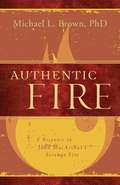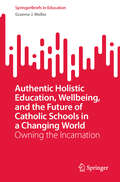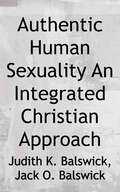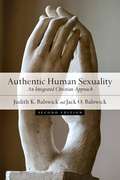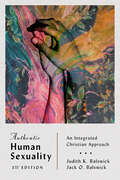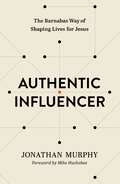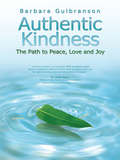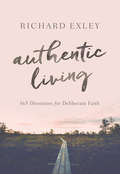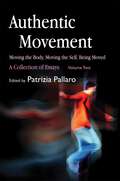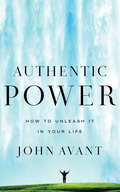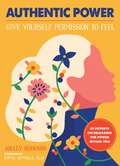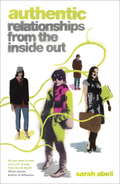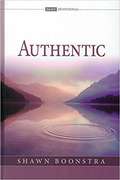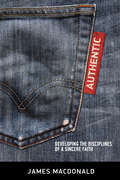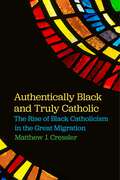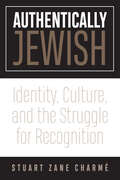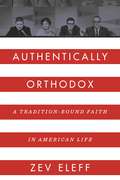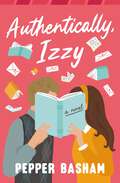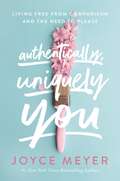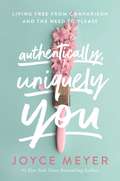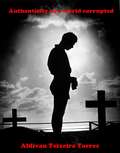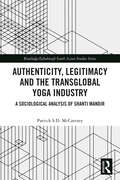- Table View
- List View
Authentic Fire: A Response to John MacArthur's Strange Fire
by Michael L. BrownIn response to Pastor John MacArthur&’s call for a &“collective war,&” against charismatics, Dr. Michael Brown has called for unity in Jesus based on a return to the truth of the Scriptures in the fullness of the Spirit. As a charismatic biblical scholar and theologian, Dr. Brown responds to Pastor MacArthur&’s charges, making a biblical case for the continuation of the New Testament gifts of the Spirit and demonstrating the unique contribution to missions, theology, and worship made by the charismatic Church worldwide. He calls for an appreciation of the unique strengths and weaknesses of both cessationists and charismatics, inviting readers to experience God afresh, and he demonstrates how charismatic leaders have been addressing abuses within their own movement for decades. Dr. Brown speaks on behalf of millions who are not adequately trained to express in writing their own encounters with the supernatural power of God. - David Ravenhill I thank God for this biblically-robust, pastorally-sensitive, historicallyinformed, and graciously-articulated account of the work of the Holy Spirit in the church of Jesus Christ. - Sam Storms Dr. Michael Brown&’s Authentic Fire puts the brakes on John MacArthur&’s crusade against charismatics with irrefutable logic, extraordinary insight, Christ-like graciousness, and an undisputable handling of Scripture. - Frank Viola Michael Brown writes with clarity and courtesy as he confronts one of the most explosive issues among all those who uphold the Bible as the plumb line of truth. - David Shibley
Authentic Fire: A Response to John Macarthur's Strange Fire
by Michael L. Brown<p>In response to Pastor John MacArthur's call for a "collective war," against charismatics, Dr. Michael Brown has called for unity in Jesus based on a return to the truth of the Scriptures in the fullness of the Spirit. <p>As a charismatic biblical scholar and theologian, Dr. Brown responds to Pastor MacArthur's charges, making a biblical case for the continuation of the New Testament gifts of the Spirit and demonstrating the unique contribution to missions, theology, and worship made by the charismatic Church worldwide. He calls for an appreciation of the unique strengths and weaknesses of both cessationists and charismatics, inviting readers to experience God afresh, and he demonstrates how charismatic leaders have been addressing abuses within their own movement for decades.</p>
Authentic Holistic Education, Wellbeing, and the Future of Catholic Schools in a Changing World: Owning the Incarnation (SpringerBriefs in Education)
by Graeme J. MellorThis book addresses the effects of the changed and changing contexts of Catholic Education in the contemporary world. These include the social, educational, and ecclesial contexts. Meaning structures, shaped by these past contexts, have broken down, and the greatest, but often unarticulated context is the anthropological context. The understanding of humanity and the meaning of human existence today is beset by a marked lack of clarity and consistent direction. Catholic Education today exists within contextual fields which are almost unrecognizable from those which existed at the close of the Second World War. Each succeeding decade since has wrought stark and dynamic change socially, educationally, and religiously. As such, Catholic Education today looks for a direction forward and a sense of purpose into the future. This book proposes that the major purpose of contemporary Catholic Education is to provide an educational context that nurtures the true holistic growth of students within its care. The focus upon Christian Humanism in contemporary Papal and Magisterial teaching sets the ground for this developing understanding.
Authentic Human Sexuality
by Jack O. Balswick Judith K. BalswickSex pervades our culture, going far beyond the confines of the bedroom into the workplace, the church, and the media. Yet despite all the attention and even obsession devoted to sex, human sexuality remains confusing and even foreboding. What, after all, is authentic human sexuality? <p><p>That is the question Judith and Jack Balswick set out to answer in this wide-ranging and probing book. Informed by sociology, psychology, and theology, the Balswicks investigate how human sexuality originates both biologically and socially. They lay groundwork for a normative Christian interpretation of sexuality, show how authentic sexuality is necessarily grounded in relationships, and explore such forms of "inauthentic sexuality" as sexual harassment, pornography, and rape. <p><p>Since its first publication, Authentic Human Sexuality has established itself as a standard text at numerous colleges and seminaries. Now this third edition features updated theological and social science research, insights from current neuropsychological evidence, and an expanded biblical model of authentic sexual relationships, along with updated discussion of sexual minorities, same-sex attraction, and LGBTQ issues. A new generation of students, pastors, psychologists, and sociologists engaged in counseling will be indebted to the Balswicks for this study of an endlessly fascinating and perplexing facet of human identity.
Authentic Human Sexuality: An Integrated Christian Approach
by Jack O. Balswick Judith K. BalswickSex pervades our culture, going far beyond the confines of the bedroom into the workplace, the church and the media. Yet despite all the attention and even obsession devoted to sex, human sexuality remains confusing and even foreboding. What, after all, is authentic human sexuality?That is the question Judith and Jack Balswick set out to answer in this wide-ranging and probing book. Informed by sociology, psychology and theology, the Balswicks investigate how human sexuality originates both biologically and socially, lay groundwork for a normative Christian interpretation of sexuality, show how authentic sexuality is necessarily grounded in relationships, and explore such forms of "inauthentic sexuality" as sexual harassment, pornography and rape. Since its first publication in 1999, Authentic Human Sexuality has established itself as a standard text at numerous colleges and seminaries. While maintaining the book's overall structure, this new paper edition offers updated discussions and bibliographies throughout, including a completely new chapter on sexual development throughout the human lifespan and a substantially revised chapter on sexual beings in relationship that incorporates a trinitarian theological perspective. A new generation of students, pastors, psychologists and sociologists engaged in counseling will be indebted to the Balswicks for this updated study of this endlessly fascinating and perplexing facet of human identity.
Authentic Human Sexuality: An Integrated Christian Approach
by Jack O. Balswick Judith K. BalswickSex pervades our culture, going far beyond the confines of the bedroom into the workplace, the church, and the media.Authentic Human Sexuality
Authentic Influencer: The Barnabas Way of Shaping Lives for Jesus
by Jonathan MurphyYou may feel like an ordinary believer, but God has a knack of using ordinary people to accomplish His extraordinary purposes. Authentic Influencer encourages you to walk with Barnabas, learn from God, and shape the world for Jesus Christ— one life at a time.God's approach to influencing the world is through His people. People shape people. And yet, many of God's people spectate from the sidelines unsure of what to do. Authentic Influencer is rooted in principles emerging from the life of God's choice example in the Scriptures—a man called Barnabas—rather than recycled quotes from corporate leadership works.Every follower of Jesus can be inspired, instructed, and mobilized to influence the world from right where they are. In fact, it is everyday believers—not just "professional" Christians such as pastors, church leaders, authors, and others—who are specifically tasked by Jesus Himself to bring godly influence to the world. We are all His agents of change, be it shaping one person or a thousand.Authentic Influencer is a Christian leadership book that:Highlights 15 key principles that emerge from Barnabas that are relevant, practical, and customizable to every believerInspires you to shape those around you for ChristUrges you to practice investing in others through discipleshipChallenges you with inspiring stories and practical wisdom emerging from biblical truthsBy studying the life of Barnabas, we see how he influenced the world for Jesus Christ in practical and doable ways. Become encouraged to shape our world for Jesus— beginning with whoever happens to be close by.
Authentic Kindness: The Path to Peace, Love and Joy
by Barbara GulbransonIn this world full of division, turmoil and despair, Barbara Gulbranson’s Authentic Kindness: The Path to Peace, Love and Joy offers a novel awareness that all of us are united as one human race, and the only way to lead a joyous and peaceful life, as well as thrive, is by practicing authentic kindness. Such an appeal can be considered as grandiose and impossible by many, especially skeptics, but the book provides a powerful, workable instrument on how to achieve it. Gulbranson shares relevant real-life stories of kindness in action and down-to-earth techniques on how to practice authentic kindness to experience unparalleled levels of peace, love and joy. Even for fist-time readers of Gulbranson’s work, one can readily appreciate her deep, enlightened thought process towards a journey of genuine healing through the practice of authentic kindness. The brilliant fusion of both Eastern and Western spirituality and philosophies narrated, along with the lives of ordinary people, offers a deep and enriching reading experience. Practical tools such as the “Kindness Tool Kit” and the guide on creating our “Bodhichitta Attitude,” which is a mental outlook that espouses “lovingkindness” helps change the lives of both the individual and those around that person.
Authentic Living: 365 Devotions for Deliberate Faith
by Richard ExleyTo live an authentic, fulfilled life we need to both understand and practice the core beliefs of the Christian faith. Being intentional about pursuing Christ is often challenging in our confusing, messy world, but like the biblical character Daniel who did not compromise his values, we must take small, deliberate steps to grow in spiritual integrity. The short, inspirational devotions in Authentic Living illustrate how we can be more deliberate in our faith each and every day through small actions like asking forgiveness, offering guidance, praying specifically, and more. With these simple yet profound readings, we can realize a more fulfilling life and faith one thought, one action, one day at a time.
Authentic Movement: A Collection of Essays - Volume Two
by Patrizia PallaroPraise for the first volume: `It is very valuable to have [this collection of articles] all together in one place...a rich repository of insights and experiences for all the somatic disciplines. It is a wonderful collection of articles.' - Somatics 1999/2000 This second volume on Authentic Movement - a new discipline aiding the creative process in choreography, writing, theatre performance, dance, graphic and expressive arts, as well as spirituality - is an engaging and dynamic collection of scholarly essays, personal stories, practical suggestions and resources. It reflects cutting edge work on creative expression, meditative discipline and psychotherapeutic endeavour. Part I comprises five chapters written by the most prominent Authentic Movement practitioners and teachers and introducing the foundations and principles of Authentic Movement. In Part II, the contributors return to the source of Authentic Movement - the psychotherapeutic setting - and provide an in-depth examination of the personal processes in the therapeutic relationship and the potential of Authentic Movement to facilitate personal growth and change. Part III traces the development of Authentic Movement as a spiritual path and as interface with other spiritual practices. Part IV provides an overview of new developments in Authentic Movement, Part V offers inspiring personal accounts and Part VI provides guidelines drawn from practice as well as tools and resources. These latter chapters sow the seeds for a new understanding and directions for the developments of Authentic Movement. This authoritative text is indispensable for practitioners of Authentic Movement, students and teachers working in the field of dance therapy, art therapists, all creative arts therapists and body psychoanalysts.
Authentic Power
by John AvantDo You Have Lift Off? Picture a NASA rocket lifting off, only seconds later to be millions of miles from earth. The force that makes such a feat possible is mind boggling. And it's only a shadow of the power you have access to every day! It's the awe-inspiring power that raised Jesus Christ from the dead, and it's yours simply because God promises it. John Avant takes a breathtaking look at Philippians 3:10-14, your key to living every moment in the same strength Jesus had as He stepped out of the tomb. The path to authentic power is not easy, but it can be experienced even through the darkest times of raw pain. Discover how to live in God's authentic power as you move toward an incredible future! Open the Floodgates Are you dry? Stuck in a routine? Looking for a boost in a measly cup of java? That's living small. And it's not for you. You were meant to live larger than life. To let God's uncontainable power transform every ounce of who you are. Why? Because when Jesus Christ stepped out of the tomb, He gave you rights to the same power that conquers even death. You can't see or touch it, earn it or achieve it. But you can live it today. How? Discover John Avant's warm storytelling style as he unveils the secret to claiming Christ's incredible power in your life. It's too consuming, too accessible, too real to ever leave you the same. "John Avant's Authentic Power reminds us that the greatest energy crisis in America is the result of the underutilized human soul, originally designed to run on high-octane, Holy Spirit-inspired power. Authentic Power teaches us to not just cope but triumph over life's challenges." Dan Cathy Owner/president, Chick-fil-A Story Behind the Book"After visiting persecuted churches in Vietnam , Belarus , and the Middle East , I was inspired. I saw something I just do not see today in the average American church--something so strong that the best descriptor is that it's supernatural. It's the power that comes from Christ. But I'm amazed that the greatest authentic power I see is wielded by those with the least power in the eyes of this world. Shortly after nearly being killed in the Middle East , I read Philippians 3:10-14 and discovered the words that unveil the secrets of real power. These are the words this book is based upon." --John AvantFrom the Trade Paperback edition.
Authentic Power: Give Yourself Permission to Feel
by Ashley Bernardi""This book has the power to heal the world one person at a time." - Lorilee Binstock, host of A Trauma Survivor's Podcast and founder of Authentic Insider MagazineWHAT IF YOU ALLOWED YOURSELF TO TRULY FEEL?Whether it’s grief, despair, or anxiety, society will always find a way to label feelings as “messy.” But burying these reactions only leads to greater emotional turmoil. In the past, we have looked to self-help gurus like Gary Zukav, whose Seat of the Soul inspired Oprah Winfrey to help America process trauma. So why did that book resonate with her, and what does everyone still love about Oprah? It's not that she's rich or that she's successful...it's her authenticity. She taps into what she has described in her SuperSoul Sundays as Authentic Power: uniting all the pieces of herself so that she's always bringing her whole self to everything she does. Oprah didn't ignore her messy feelings: she shared them with America, and she processed and integrated them in order to tap into her own authentic power. She became her authentic self, which exudes from her in every second that you see her.In Authentic Power: Give Yourself Permission to Feel, accomplished entrepreneur, journalist, publicist, and award-winning podcaster Ashley Bernardi continues the brave work of these great thought leaders by teaching you that your darkest hours are disguised opportunities to uncover and process, feel, heal, and grow.Bernardi’s personal journey began when she witnessed her father’s sudden death at age eleven. Years later, a mysterious illness began a personal quest toward healing and taught her that trauma and adversity can be sources of strength and self-discovery. Through daily affirmations and writing prompts, you will discover Ashley Bernardi’s F.E.E.L. Framework:FocusEnterExperienceLearn You will explore chapters such as: Embrace the Waves of EmotionsLift the Emotional FogMake Space for the Brave ConversationsThe F.E.E.L. FrameworkBalanced Body, Balanced HeartDiscover Your Deeper, Powerful, SelfExercise Your EmpathyAs the founder of a national media relations and publicity firm, Ashley has the privilege of access to many of the world's leading experts in health and wellness who offered healing and hope with her personal challenges—a rich collection of top doctors, neurologists, psychologists, nutritionists, coaches, spiritualists, and others. She shares their profound wisdom so that you can build hope during your times of struggle.Bernardi searched for true healing and growth for more than twenty years; Authentic Power equips you with the tools to ignite your own journey now. "Through daily affirmations, exercises, and journaling prompts...Bernardi walks readers through her FEEL framework—focus, enter, experience, and learn— to help them find a way forward after experiencing trauma." —Publishers Weekly"Ashley Bernardi completely reveals herself and therefore all of us with a compendium of powerful words, wisdom and practices to put into place immediately." —Dana Look-Arimoto, host of Settle Smarter Podcast and author of Stop Settling, Settle Smart
Authentic.: Relationships from the Inside Out
by Sarah Abell"[Authentic] offers hope to anyone who has ever wished for stronger friendships, deeper relationships - and to be a better person” Rob Parsons, Care for the Family97.5% of people admit their relationships could be improved64% of people don’t think they give enough time to their close friendships59% of single people often feel lonely80% of people don’t respect their bossAre your friendships as strong as you’d like them to be? Are you struggling with a relationship at the moment? Have you ever wondered why some people make you react in a certain way. Perhaps you long for more time to spend with your loved ones, or for loved ones that you would want to spend more time with. Do you wish you didn’t lose your temper so much or that you could express your emotions more easily? Would you like to understand those around you better? If you want to have genuine, meaningful relationships with anyone everyone in your life AUTHENTIC is the book for you. Full of practical advice, it will show you how to invest in authentic relationships - one of the most rewarding adventures we can ever undertake.
Authentic: Daily Devotional
by Shawn BoonstraEach entry in Authentic is a moment of reflection, a brief peek at one small facet of the stunning picture of Jesus provided to us in the three angels' messages. In preparing to claim the belief of the Adventist movement as the foundation for their faith, baptismal candidates are asked to claim thirteen vows as their own. This new devotional by Pastor Shawn Boonstra is dedicated to highlighting these thirteen truths in the light of glory of Jesus Christ, our Creator and our Redeemer. According to Boonstra, understanding our Adventist doctrines-from the sanctuary and the Sabbath to the health message and the state of the dead-leads us to a better understanding of the mind of God and to a more intimate knowledge of Christ. Pastor Boonstra states, "It is my prayer for you this year, that you will find yourself drawn ever closer to the One who stepped down from glory to be closer to you."
Authentic: Developing the Disciplines of a Sincere Faith
by James MacDonaldHas hypocrisy crept into your life?It doesn&’t just happen overnight. Drifting into hypocrisy is a long, drawn-out journey away from God&’s will for your life and toward a two-faced existence. How do you know when your inner self has deteriorated, when you've become an expert at presenting a faithful-looking facade? Hold up the mirror of God's Word and take a good look. Acting like a Christian and saying all the right words sometimes leads to nothing more than empty piety. If you want to live that vibrant life, if you want to be truly blessed, you must get after the disciplines of genuine faith. Follow along with Pastor James MacDonald on the road toward Truth and explore the disciplines of personal Bible study, personal prayer, fasting, fellowship, and service for Christ.Become the real deal. Be authentic.
Authentic: Developing the Disciplines of a Sincere Faith
by James MacDonaldHas hypocrisy crept into your life?It doesn&’t just happen overnight. Drifting into hypocrisy is a long, drawn-out journey away from God&’s will for your life and toward a two-faced existence. How do you know when your inner self has deteriorated, when you've become an expert at presenting a faithful-looking facade? Hold up the mirror of God's Word and take a good look. Acting like a Christian and saying all the right words sometimes leads to nothing more than empty piety. If you want to live that vibrant life, if you want to be truly blessed, you must get after the disciplines of genuine faith. Follow along with Pastor James MacDonald on the road toward Truth and explore the disciplines of personal Bible study, personal prayer, fasting, fellowship, and service for Christ.Become the real deal. Be authentic.
Authentic: Relationships From The Inside Out
by Sarah Abell"[Authentic] offers hope to anyone who has ever wished for stronger friendships, deeper relationships - and to be a better person? Rob Parsons, Care for the Family97.5% of people admit their relationships could be improved64% of people don?t think they give enough time to their close friendships59% of single people often feel lonely80% of people don?t respect their bossAre your friendships as strong as you?d like them to be? Are you struggling with a relationship at the moment? Have you ever wondered why some people make you react in a certain way. Perhaps you long for more time to spend with your loved ones, or for loved ones that you would want to spend more time with. Do you wish you didn?t lose your temper so much or that you could express your emotions more easily? Would you like to understand those around you better? If you want to have genuine, meaningful relationships with anyone everyone in your life AUTHENTIC is the book for you. Full of practical advice, it will show you how to invest in authentic relationships - one of the most rewarding adventures we can ever undertake.
Authentically Black and Truly Catholic: The Rise of Black Catholicism in the Great Migration
by Matthew J. CresslerExplores the contentious debates among Black Catholics about the proper relationship between religious practice and racial identity Chicago has been known as the Black Metropolis. But before the Great Migration, Chicago could have been called the Catholic Metropolis, with its skyline defined by parish spires as well as by industrial smoke stacks and skyscrapers. This book uncovers the intersection of the two. Authentically Black and Truly Catholic traces the developments within the church in Chicago to show how Black Catholic activists in the 1960s and 1970s made Black Catholicism as we know it today. The sweep of the Great Migration brought many Black migrants face-to-face with white missionaries for the first time and transformed the religious landscape of the urban North. The hopes migrants had for their new home met with the desires of missionaries to convert entire neighborhoods. Missionaries and migrants forged fraught relationships with one another and tens of thousands of Black men and women became Catholic in the middle decades of the twentieth century as a result. These Black Catholic converts saved failing parishes by embracing relationships and ritual life that distinguished them from the evangelical churches proliferating around them. They praised the “quiet dignity” of the Latin Mass, while distancing themselves from the gospel choirs, altar calls, and shouts of “amen!” increasingly common in Black evangelical churches. Their unique rituals and relationships came under intense scrutiny in the late 1960s, when a growing group of Black Catholic activists sparked a revolution in U.S. Catholicism. Inspired by both Black Power and Vatican II, they fought for the self-determination of Black parishes and the right to identify as both Black and Catholic. Faced with strong opposition from fellow Black Catholics, activists became missionaries of a sort as they sought to convert their coreligionists to a distinctively Black Catholicism. This book brings to light the complexities of these debates in what became one of the most significant Black Catholic communities in the country, changing the way we view the history of American Catholicism.
Authentically Jewish: Identity, Culture, and the Struggle for Recognition
by Stuart Z. CharméThis book analyzes the different conceptions of authenticity that are behind conflicts over who and what should be recognized as authentically Jewish. Although the concept of authenticity has been around for several centuries, it became a central focus for Jews since existentialist Jean-Paul Sartre raised the question in the 1940s. Building on the work of Sartre, later Jewish thinkers, philosophers, anthropologists, and cultural theorists, the book offers a model of Jewish authenticity that seeks to balance history and tradition, creative freedom and innovation, and the importance of recognition among different groups within an increasingly multicultural Jewish community. Author Stuart Z. Charmé explores how debates over authenticity and struggles for recognition are a key to understanding a wide range of controversies between Orthodox and liberal Jews, Zionist and diaspora Jews, white Jews and Jews of color, as well as the status of intermarried and messianic Jews, and the impact of Jewish genetics. In addition, it discusses how and when various cultural practices and traditions such as klezmer music, Israeli folk dance, Jewish yoga and meditation, and others are recognized as authentically Jewish, or not.
Authentically Orthodox: A Tradition-Bound Faith in American Life
by Zev EleffWith a fresh perspective, Authentically Orthodox: A Tradition-Bound Faith in American Life challenges the current historical paradigm in the study of Orthodox Judaism and other tradition-bound faith communities in the United States.Paying attention to "lived religion," the book moves beyond sermons and synagogues and examines the webs of experiences mediated by any number of American cultural forces. With exceptional writing, Zev Eleff lucidly explores Orthodox Judaism’s engagement with Jewish law, youth culture and gender, and how this religious group has been affected by its indigenous environs. To do this, the book makes ample use of archives and other previously unpublished primary sources. Eleff explores the curious history of Passover peanut oil and the folkways and foodways that battled in this culinary arena to both justify and rebuff the validity of this healthier substitute for other fatty ingredients. He looks at the Yeshiva University quiz team’s fifteen minutes of fame on the nationally televised College Bowl program and the unprecedented pride of young people and youth culture in the burgeoning Modern Orthodox movement. Another chapter focuses on the advent of women’s prayer groups as an alternative to other synagogue experiences in Orthodox life and the vociferous opposition it received on the grounds that it was motivated by "heretical" religious and social movements. Whereas past monographs and articles argue that these communities have moved right toward a conservative brand of faith, Eleff posits that Orthodox Judaism—like other like-minded religious enclaves—ought to be studied in their American religious contexts. The microhistories examined in Authentically Orthodox are some of the most exciting and understudied moments in American Jewish life and will hold the interest of scholars and students of American Jewish history and religion.
Authentically, Izzy
by Pepper BashamDear Reader, My name is Isabelle Louisa Edgewood—Izzy, for short. I live by blue-tinted mountains, where I find contentment in fresh air and books. Oh, and coffee and tea, of course. And occasionally in being accosted by the love of my family. (You&’ll understand my verb choice in the phrase later.) I dream of opening my own bookstore, but my life, particularly my romantic history, has not been the stuff of fairy tales. Which is probably why my pregnant, misled, matchmaking cousin—who, really, is more like my sister—signed me up for an online dating community.The trouble is . . . it worked. I&’ve met my book-quoting Mr. Right, and our correspondence has been almost too good to be true. But Brodie lives across an ocean. And just the other day, a perfectly nice author and professor named Eli came into the library where I work and asked me out for a coffee. I feel a rom-com movie with a foreboding disaster nipping at my heels.But I&’ve played it safe for a long time. Maybe it&’s time for me to be as brave as my favorite literary heroines. Maybe it&’s time to take the adventures from the page to real life. Wish me luck.Authentically,IzzyWitty, hilarious, and heartwarming contemporary romance about book lovers A sweet, kisses-only romance An epistolary novel written mostly in emails and texts Stand-alone novel Book length: approximately 105,000 words Includes discussion questions for book clubs
Authentically, Uniquely You: Living Free from Comparison and the Need to Please
by Joyce MeyerDiscover your unique gifts and dare to be different with #1 New York Times bestselling author and renowned Bible teacher, Joyce Meyer.God has given you gifts so you can fulfill His purpose for your life, but if you're like a lot of people, you may not have recognized your talents yet. Start asking God to show you something special about the way He's made you.To some people, He's given a very tender, compassionate heart, and some He has wired to lead others effectively. Others, He has given a gift of being able to communicate clearly, to teach, to make scientific discoveries, or to write beautiful music. Only you can discover all the dynamic gifts He's placed in you.Become Authentically, Uniquely You because God is never going to help you be anyone but yourself. He loves you just as you are. Let God use you, with all your strengths and weaknesses, and transform you from the inside out to do something powerful beyond your wildest dreams.
Authentically, Uniquely You: Living Free from Comparison and the Need to Please
by Joyce MeyerDiscover your unique gifts and dare to be different with #1 New York Times bestselling author and renowned Bible teacher, Joyce Meyer.God has given you gifts so you can fulfill His purpose for your life, but if you're like a lot of people, you may not have recognized your talents yet. Start asking God to show you something special about the way He's made you.To some people, He's given a very tender, compassionate heart, and some He has wired to lead others effectively. Others, He has given a gift of being able to communicate clearly, to teach, to make scientific discoveries, or to write beautiful music. Only you can discover all the dynamic gifts He's placed in you.Become Authentically, Uniquely You because God is never going to help you be anyone but yourself. He loves you just as you are. Let God use you, with all your strengths and weaknesses, and transform you from the inside out to do something powerful beyond your wildest dreams.
Authenticity in a world corrupted
by Aldivan Teixeira TorresThe tale shows the values needed to live well the life and to change your reality. Through insightful advice, points a way to reach the o success and the happiness. Do not miss this opportunity from change.
Authenticity, Legitimacy and the Transglobal Yoga Industry: A Sociological Analysis of Shanti Mandir (Routledge/Edinburgh South Asian Studies Series)
by Patrick S.D. McCartneyThis book is a sociological study of knowledge and knowers and explores the production and perceived value of ‘yogic knowledge,’ how distinction is curated, and how access to this knowledge is gained.The book focuses on the organization Shanti Mandir (SM) in India, a new religious movement, which was founded in 1987 by Swami Nityananda Saraswati. It is a non-profit charity operating within the unregulated and competitive multi-billion dollar global and domestic wellness/spiritual tourism industries, and as a registered education provider within India’s education industry. The main aim of this book is to answer the question how legitimacy is acquired, negotiated and expressed within the SM yoga ashram. The theoretical framework applied in this study is a confluence of the sociology of education, knowledge and religion. The author engages a methodology based primarily on ethnographic participant-observation and discourse analysis. Situating SM within the transglobal yoga and spiritual tourism industries, the book demonstrates how SM promotes itself as a provider of a consumable lifestyle that spiritual aspirants can adopt through attending retreats, workshops, meditation intensives, yoga teacher training and philosophy courses in their global network of ashrams. By identifying the structuring forces of the guru’s discourse, and focusing on the marketing strategies and subsequent exchanges of capital and affective emotions, this monograph documents what the legitimate yogic identity promoted by SM is within the context of the transglobal yoga industry.A highly original and incisive portrait of an Indian devotional community with strong transnational connections, this book will be of interest to researchers studying South Asian Studies, Religious Studies, Indian religion and yoga.

